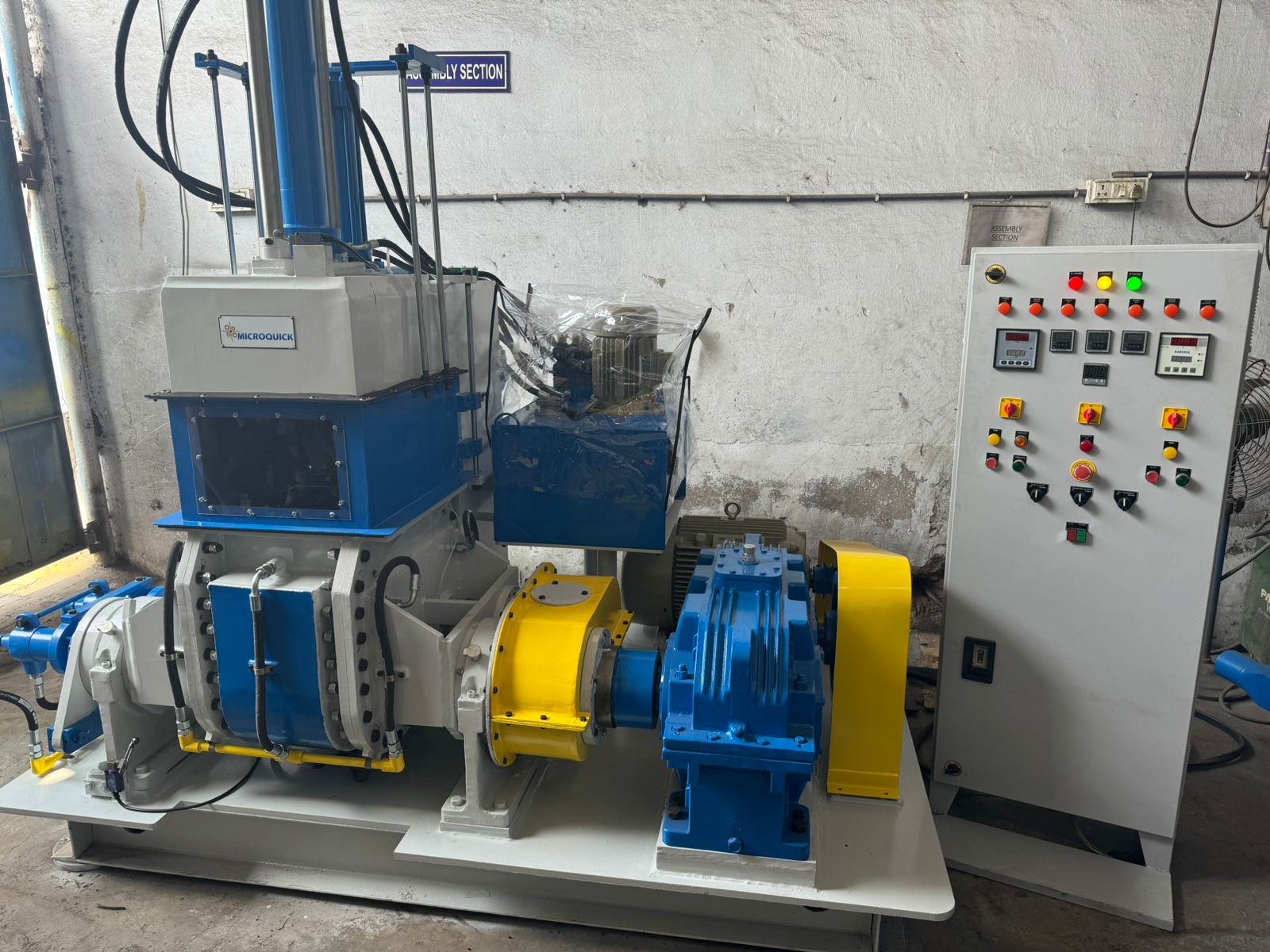Rubber mixing plays a crucial role in the manufacturing process, ensuring the quality and consistency of the final product. Whether it’s automotive parts, industrial components, consumer products, healthcare devices, electrical insulation, or other rubber industries, the importance of quality cannot be overstated.
A rubber mixer is responsible for achieving the desired properties of the rubber compounds, such as uniformity, dispersion of additives, and optimal curing. By controlling the mixing parameters, such as temperature, time, and rotor speed, a rubber mixer ensures that the rubber compounds meet the required specifications.
Impact on Various Industries
In various industries, the quality of rubber mixing directly impacts the performance, durability, and safety of the end products.
– In the automotive industry, high-quality rubber compounds are essential for tire performance, sealing systems, and vibration control.
– In the healthcare industry, precise rubber mixing is critical for medical devices and equipment.
Investing in Advanced Rubber Mixing Technology
To meet the increasing demand for quality rubber products, manufacturers need to invest in advanced rubber mixing technology and equipment. By doing so, they can achieve consistent and high-quality output, reduce material waste, and improve overall productivity.
Rubber Mixing: Importance and Process
Rubber mixing is a crucial process in the manufacturing industry as it plays a significant role in producing high-quality rubber compounds. By understanding the concept of rubber mixing and its importance, manufacturers can improve their overall production efficiency and product consistency.
What is Rubber Mixing?
Rubber mixing involves the blending of various raw materials to create a homogeneous mixture. The raw materials used in the process include rubber, fillers, additives, and curing agents. This process is essential because it determines the final properties of the rubber compound, including its strength, flexibility, and durability. Without proper mixing, the compound may have uneven distribution of fillers and additives, leading to inconsistent product quality.
Types of Rubber Mixers
- Open mill mixers (two-roll mills): These mixers consist of two rotating rollers that crush and blend the raw materials together. They are commonly used for mixing rubber compounds.
- Internal mixers (e.g. Banbury mixers): These mixers use a rotating chamber and mixing blades to achieve thorough dispersion of the ingredients.
- Continuous mixers: These mixers provide a continuous flow of mixed rubber compound, allowing for high-volume production.
Key Components and Features
The effectiveness and efficiency of a rubber mixer depend on its key components and features:
-
Weighing and measuring equipment:
Ensures accurate proportions of raw materials. -
Temperature control systems:
Maintain optimal mixing conditions. -
Automation systems:
Streamline the mixing process, reducing human error and increasing productivity.
These components and features work together to create a controlled and consistent mixing environment, resulting in high-quality rubber compounds.
Understanding rubber mixing and its significance in the manufacturing process is crucial for producing high-quality rubber compounds. Different types of rubber mixers, such as open mill mixers, internal mixers, and continuous mixers, offer unique advantages and can be chosen based on specific production needs. Key components and features of a rubber mixer, including
weighing and measuring equipment
, temperature control systems, and automation, contribute to efficient and consistent mixing. By investing in the right
rubber mixing equipment
and optimizing the mixing process, manufacturers can enhance their production efficiency and ensure the quality of their rubber products.
The Importance of Rubber Mixing in Rubber Manufacturing
Rubber mixing plays a crucial role in achieving consistent
quality and performance in rubber
manufacturing. By thoroughly blending the raw materials, rubber mixing ensures that the final product meets the desired specifications. Let’s explore why rubber mixing is so important and how it contributes to the overall quality of rubber products.
Benefits of Rubber Mixing
-
Proper Dispersion of Additives and Fillers:
Rubber mixing achieves proper dispersion of additives such as plasticizers, antioxidants, and curing agents, as well as fillers like carbon black or silica. This uniform distribution of components ensures that the desired properties are consistently present in the final product. -
Prevention of Issues:
Rubber mixing helps prevent issues like overheating, premature curing, and inadequate mixing time. By controlling temperature, mixing time, and curing agents, rubber mixing ensures optimal curing and cross-linking, resulting in a stronger and more durable rubber product. -
Mitigation of Inconsistent Material Quality:
Inconsistent material quality can affect the properties of the final rubber product. Rubber mixing mitigates this risk by thoroughly blending the raw materials, minimizing variations in quality and achieving consistent properties.
Rubber mixing is a critical step in the rubber manufacturing process. It ensures consistent quality and performance by achieving proper dispersion of additives and fillers, preventing issues like overheating and premature curing, and mitigating the impact of inconsistent material quality. Manufacturers can produce high-quality rubber products by investing in reliable
rubber mixing equipment
and following best practices.
The Benefits of Using a Rubber Mixer in the Manufacturing Process
Rubber mixers play a crucial role in the manufacturing process, offering a range of benefits that contribute to improved efficiency, productivity, and quality. By understanding these advantages, businesses can make informed decisions about incorporating rubber mixers into their operations.
Improved Efficiency
- Traditional methods of rubber compounding can be time-consuming and labor-intensive.
- Rubber mixers, like Microquick Engineers’ Hydraulic Dispersion Kneaders, significantly reduce batch preparation times.
- Batch preparation times range from 7 to 12 minutes, resulting in efficient production.
- Increased efficiency allows businesses to meet customer demands more effectively.
Enhanced Productivity
- Automated continuous hydraulic ram pressure ensures excellent compounding performance.
- No manual intervention is required, reducing the risk of human error.
- Consistent quality compounding is achieved, resulting in high-quality rubber products.
- Wear-resistant properties of the mixing chamber and rotors ensure durability and increased productivity.
Consistent Mixing Performance
- Rubber mixers, such as Microquick Engineers’ Hydraulic Dispersion Kneaders, provide excellent dispersion of ingredients.
- Excellent dispersion results in consistent and uniform compounds.
- Final rubber products meet required specifications and perform as intended.
Quality Assurance and Testing
- Microquick Engineers has over 25 years of experience and a high customer satisfaction rate.
- Rubber mixers undergo rigorous testing to ensure optimal performance and adherence to quality standards.
- Using a rubber mixer with built-in testing capabilities reduces the risk of product defects.
Application-Specific Advantages
Rubber mixers can be customized to meet the specific requirements of different industries, including automotive, industrial, consumer products, healthcare, electrical, and others. This versatility allows businesses to adapt and cater to the unique needs of their target markets.
Operational Challenges in Rubber Mixing and Solutions
Rubber mixing is a critical process in the manufacturing of various rubber products, including automotive parts, industrial components, consumer goods, and healthcare equipment. However, it is not without its challenges. In this section, we will discuss some common operational challenges faced in rubber mixing and explore effective solutions and best practices to overcome them.
Inconsistent Material Quality
One of the main
challenges in rubber mixing
is inconsistent material quality. This can lead to variations in the final product’s performance and durability. Factors such as impurities in raw materials or inadequate blending can result in uneven dispersion of additives and fillers, affecting the overall quality of the compound.
- Carefully select high-quality raw materials
- Implement rigorous testing procedures
- Optimize mixing parameters
- Employ advanced mixing techniques, such as high-intensity mixers or inline monitoring systems
Overheating and Premature Curing
Another operational challenge in rubber mixing is overheating and premature curing. Excessive heat can degrade the rubber compound, affecting its physical properties and leading to product defects.
- Monitor and control the temperature during the mixing process
- Calibrate temperature control equipment
- Use cooling systems
- Ensure appropriate mixing times
Inadequate Mixing Time
Inadequate mixing time is also a common challenge in rubber mixing. Insufficient mixing time can result in inadequate dispersion of additives and fillers, leading to compromised product performance.
- Establish optimal mixing times based on specific requirements
- Optimize the mixing process through process optimization and monitoring
- Provide operator training on proper mixing techniques and equipment operation
Proper Maintenance, Calibration, and Operator Training
Proper maintenance, calibration, and operator training are key factors in overcoming operational challenges in rubber mixing.
- Regular equipment maintenance, including cleaning and lubrication
- Calibration of temperature control equipment and other critical parameters
- Comprehensive training on proper mixing techniques, equipment operation, and quality control procedures
Case Studies: Demonstrating the Real-World Benefits of Rubber Mixers
Rubber mixers have proven to be invaluable in various industries, revolutionizing manufacturing processes and improving product quality. By examining case studies, we can gain insights
into how rubber mixing techniques
and innovations have contributed to advancements in aerospace, healthcare, and automotive sectors. Let’s explore these case studies and understand the role of advanced mixing techniques in enhancing quality and productivity.
Aerospace Industry: Enhancing Safety and Reliability
In the aerospace industry, rubber mixers have played a crucial role in the production of aircraft components. For instance, high-performance rubber seals that can withstand extreme temperatures and pressure differentials are created using rubber mixers. These seals are vital for ensuring the safety and reliability of aircraft engines and fuel systems. Advanced mixing techniques, such as high-intensity mixers, enable better dispersion of additives and fillers, resulting in improved performance and durability of rubber seals.
Healthcare Sector: Ensuring Precision and Consistency
Rubber mixers are extensively used in the healthcare sector for the manufacturing of medical devices and equipment. One notable case study involves the production of silicone rubber prosthetics. The use of rubber mixers with precise control over the mixing process ensures consistent quality and performance of the prosthetics. Advanced mixing techniques, including inline monitoring, facilitate real-time quality control and adjustments, meeting the required specifications. This level of precision and consistency is vital in the healthcare industry, prioritizing patient safety and comfort.
Automotive Sector: Achieving Optimal Performance and Durability
The automotive industry greatly benefits from rubber mixing techniques and innovations. A case study showcasing these advantages is the production
of automotive rubber parts
, including seals, gaskets, and hoses. Rubber mixers enable manufacturers to achieve optimal material properties, such as high tensile strength, excellent elasticity, and resistance to chemicals and extreme temperatures. This results in automotive rubber parts that can withstand harsh operating conditions and provide long-lasting performance. Advanced mixing techniques, like high-intensity mixers, contribute to faster and more efficient production, leading to increased productivity and cost savings.
These case studies demonstrate the significant impact of rubber mixing techniques and innovations across various industries. Advanced mixing techniques, such as high-intensity mixers and inline monitoring, have led to improved quality, productivity, and cost savings. Whether in aerospace, healthcare, or automotive sectors,
the benefits of using rubber
mixers are clear. From creating high-performance aircraft components to producing precise medical devices and durable automotive rubber parts, rubber mixers play a vital role in shaping the future of these industries.
The Importance of Rubber Mixing and the Role of a Rubber Mixer
When it comes to rubber mixing, quality is of utmost importance. Consistency in the final product is crucial for achieving the desired properties and performance. This is where a rubber mixer plays a vital role. It ensures that the rubber compounds are thoroughly mixed, resulting in a uniform blend of ingredients.
Benefits of Using a Rubber Mixer
- Improved Efficiency and Productivity: Using a rubber mixer with automated continuous hydraulic ram pressure reduces batch preparation times, resulting in faster production and higher output. Microquick Engineers’ Hydraulic Dispersion Kneaders, for example, have batch preparation times ranging from 7 to 12 minutes, ensuring efficient and streamlined production.
- Enhanced Mixing Performance and Consistency: Rubber mixers, like Microquick Engineers’ kneaders, provide excellent dispersion of ingredients, resulting in a homogeneous mixture. This consistency is crucial for ensuring the quality and performance of the final product. Microquick Engineers’ kneaders are suitable for various industries such as automotive, industrial, consumer products, healthcare, electrical, and other rubber industries.
- Durability: The mixing chamber and rotors of Microquick Engineers’ kneaders have wear resistance properties, ensuring long-lasting performance. Additionally, these kneaders have low energy consumption, contributing to cost reduction and sustainability.
Conclusion
A rubber mixer plays a crucial role in ensuring the quality and consistency of rubber mixing. It improves efficiency, enhances mixing performance, and provides consistent quality compounding . Microquick Engineers’ Hydraulic Dispersion Kneaders are a reliable solution for achieving high-quality rubber mixing. With over 25 years of experience in the industry, Microquick Engineers has established itself as a leading manufacturer and exporter of Hydraulic Dispersion Kneaders. If you are looking for a reliable and efficient solution for your rubber mixing needs, we encourage you to explore Microquick Engineers’ range of kneaders.
About Microquick Engineers’ Hydraulic Dispersion Kneaders
Microquick Engineers is a trusted manufacturer and exporter of Hydraulic Dispersion Kneaders. These kneaders offer excellent compounding performance with automated continuous hydraulic ram pressure on ingredients.
Key features of Microquick Engineers’ Hydraulic Dispersion Kneaders:
- Batch preparation times ranging from 7-12 minutes
- Excellent dispersion of ingredients and consistent quality compounding
- Suitable for various industries: automotive, industrial, consumer products, healthcare, electrical, and other rubber industries
- Durability: mixing chamber and rotors with wear resistance properties
- Low energy consumption, contributing to cost reduction and sustainability
With over 25 years of experience in the industry and a high customer satisfaction rate, Microquick Engineers is a reliable partner for all your dispersion kneader needs.
To learn more about Microquick Engineers’ Hydraulic Dispersion Kneaders and how they can optimize your production process, visit their website . You can also explore related blog posts and webpages, such as:
- 10 Tips for Optimizing Performance and Efficiency of Your Dispersion Mixer
- Tips to Enhance Automotive Rubber Parts Quality
- Importance of Energy Efficiency in Rubber Processing Equipment
- Advancements in Hydraulic Compression Technology for Rubber Manufacturing
Remember, Microquick Engineers’ Hydraulic Dispersion Kneaders are designed to meet specific industry requirements and deliver outstanding results. Take the first step towards improving your production process by exploring the possibilities with Microquick Engineers.


